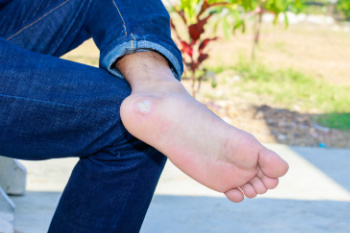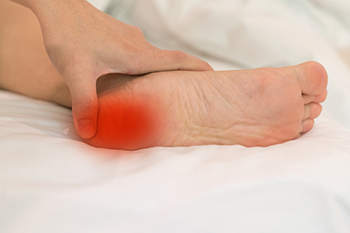Connect With Us
Blog
Items filtered by date: May 2025
Plantar Warts Can Cause Discomfort

Plantar warts are small, rough growths that appear on the bottom of the foot, usually on weight-bearing areas like the heel or ball of the foot. They are caused by the human papillomavirus, or HPV, which enters the skin through tiny cuts or cracks, often in places like public showers, gyms, or pool areas. Plantar warts may look like a callus, but often have a rough surface with black dots, which are tiny clotted blood vessels, at the center. The warts can be painful, especially while walking or standing, as pressure pushes them deeper into the skin. A podiatrist can diagnose plantar warts and offer effective treatments that go beyond over-the-counter options. These may include cryotherapy, topical acids, immune-boosting treatments, or minor surgical removal. Custom orthotics may also be recommended to reduce pressure on the area during healing. If you have a painful plantar wart, it is suggested that you schedule an appointment with a podiatrist for appropriate treatment.
Plantar warts can be very uncomfortable. If you need your feet checked, contact Emil Babayev, DPM from New York. Our doctor will assist you with all of your foot and ankle needs.
About Plantar Warts
Plantar warts are the result of HPV, or human papillomavirus, getting into open wounds on the feet. They are mostly found on the heels or balls of the feet.
While plantar warts are generally harmless, those experiencing excessive pain or those suffering from diabetes or a compromised immune system require immediate medical care. Plantar warts are easily diagnosed, usually through scraping off a bit of rough skin or by getting a biopsy.
Symptoms
- Lesions on the bottom of your feet, usually rough and grainy
- Hard or thick callused spots
- Wart seeds, which are small clotted blood vessels that look like little black spots
- Pain, discomfort, or tenderness of your feet when walking or standing
Treatment
- Freezing
- Electric tool removal
- Laser Treatment
- Topical Creams (prescription only)
- Over-the-counter medications
To help prevent developing plantar warts, avoid walking barefoot over abrasive surfaces that can cause cuts or wounds for HPV to get into. Avoiding direct contact with other warts, as well as not picking or rubbing existing warts, can help prevent the further spread of plantar warts. However, if you think you have developed plantar warts, speak to your podiatrist. He or she can diagnose the warts on your feet and recommend the appropriate treatment options.
If you have any questions, please feel free to contact our offices located in Midwood and Kensington in Brooklyn, NY . We offer the newest diagnostic and treatment technologies for all your foot care needs.
Foot Shapes and Their Impact

Foot shapes, which vary from person to person, can influence comfort, posture, and shoe fit. The Egyptian foot has a long big toe with toes slanting down in length, often leading to bunion development from tight footwear. The Greek foot features a second toe longer than the big toe, which may cause pressure and pain in closed shoes or during activity. The square foot, where the toes are nearly the same length, can lead to difficulty finding well-fitting shoes and may cause rubbing and calluses. One of the rarest shapes is the Simian foot, where toes are tightly bunched, increasing discomfort and balance issues. If you have an unusual foot shape that is causing pain or difficulty in completing daily activities, it is suggested that you consult a podiatrist who can guide you on wearing the correct type of shoe and offer relief tips for existing discomfort.
Foot Pain
Foot pain can be extremely painful and debilitating. If you have a foot pain, consult with Emil Babayev, DPM from New York. Our doctor will assess your condition and provide you with quality foot and ankle treatment.
Causes
Foot pain is a very broad condition that could be caused by one or more ailments. The most common include:
- Bunions
- Hammertoes
- Plantar Fasciitis
- Bone Spurs
- Corns
- Tarsal Tunnel Syndrome
- Ingrown Toenails
- Arthritis (such as Gout, Rheumatoid, and Osteoarthritis)
- Flat Feet
- Injury (from stress fractures, broken toe, foot, ankle, Achilles tendon ruptures, and sprains)
- And more
Diagnosis
To figure out the cause of foot pain, podiatrists utilize several different methods. This can range from simple visual inspections and sensation tests to X-rays and MRI scans. Prior medical history, family medical history, and any recent physical traumatic events will all be taken into consideration for a proper diagnosis.
Treatment
Treatment depends upon the cause of the foot pain. Whether it is resting, staying off the foot, or having surgery; podiatrists have a number of treatment options available for foot pain.
If you have any questions, please feel free to contact our offices located in Midwood and Kensington in Brooklyn, NY . We offer the newest diagnostic and treatment technologies for all your foot care needs.
Are Bunions Affecting Your Everyday Life?
The Hidden Effects of High Heels on Foot Health

Wearing high heels may enhance appearance, but they can have negative effects on foot health. High heels place added pressure on the ball of the foot, which can lead to pain, inflammation, and long-term joint stress. This unnatural positioning can also change the way a person walks, known as gait, by shortening the stride and causing instability. Over time, these changes may affect balance and coordination. High heels can also influence posture by shifting the body’s weight forward, which may disrupt the natural curves in the lower back. Limiting heel height and choosing supportive footwear more often can help protect the health and comfort of your entire body. If you enjoy wearing high heels and have developed foot pain, it is suggested that you contact a podiatrist who can offer relief solutions, and guide you on a better type of shoe to wear.
High heels have a history of causing foot and ankle problems. If you have any concerns about your feet or ankles, contact Emil Babayev, DPM from New York. Our doctor can provide the care you need to keep you pain-free and on your feet.
Effects of High Heels on the Feet
High heels are popular shoes among women because of their many styles and societal appeal. Despite this, high heels can still cause many health problems if worn too frequently.
Which Parts of My Body Will Be Affected by High Heels?
- Ankle Joints
- Achilles Tendon – May shorten and stiffen with prolonged wear
- Balls of the Feet
- Knees – Heels cause the knees to bend constantly, creating stress on them
- Back – They decrease the spine’s ability to absorb shock, which may lead to back pain. The vertebrae of the lower back may compress.
What Kinds of Foot Problems Can Develop from Wearing High Heels?
- Corns
- Calluses
- Hammertoe
- Bunions
- Morton’s Neuroma
- Plantar Fasciitis
How Can I Still Wear High Heels and Maintain Foot Health?
If you want to wear high heeled shoes, make sure that you are not wearing them every day, as this will help prevent long term physical problems. Try wearing thicker heels as opposed to stilettos to distribute weight more evenly across the feet. Always make sure you are wearing the proper shoes for the right occasion, such as sneakers for exercising. If you walk to work, try carrying your heels with you and changing into them once you arrive at work. Adding inserts to your heels can help cushion your feet and absorb shock. Full foot inserts or metatarsal pads are available.
If you have any questions, please feel free to contact our offices located in Midwood and Kensington in Brooklyn, NY . We offer the newest diagnostic and treatment technologies for all your foot care needs.
Treating Heel Pain in Growing Kids

Sever's disease, known as calcaneal apophysitis, is a common source of heel pain in growing children. Conservative management typically consists of reducing high-impact activities, easing pain and inflammation, and performing gentle stretches to relax tight calf muscles. Rest and wearing supportive footwear are beneficial in alleviating pressure on the heel. Other treatment methods may include the use of custom orthotics to improve foot alignment, or, in persistent cases, immobilization with casts to allow the heel to heal. Overall, treatment is individualized based on the child, the severity of symptoms, and daily activity demands. If your child displays worsening heel pain or discomfort, it is suggested that you see a podiatrist for a proper diagnosis and appropriate treatment.
Sever's disease often occurs in children and teens. If your child is experiencing foot or ankle pain, see Emil Babayev, DPM from New York. Our doctor can treat your child’s foot and ankle needs.
Sever’s Disease
Sever’s disease is also known as calcaneal apophysitis, which is a medical condition that causes heel pain I none or both feet. The disease is known to affect children between the ages of 8 and 14.
Sever’s disease occurs when part of the child’s heel known as the growth plate (calcaneal epiphysis) is attached to the Achilles tendon. This area can suffer injury when the muscles and tendons of the growing foot do not keep pace with bone growth. Therefore, the constant pain which one experiences at the back of the heel will make the child unable to put any weight on the heel. The child is then forced to walk on their toes.
Symptoms
Acute pain – Pain associated with Sever’s disease is usually felt in the heel when the child engages in physical activity such as walking, jumping and or running.
Highly active – Children who are very active are among the most susceptible in experiencing Sever’s disease, because of the stress and tension placed on their feet.
If you have any questions, please feel free to contact our offices located in Midwood and Kensington in Brooklyn, NY . We offer the newest diagnostic and treatment technologies for all your foot care needs.

